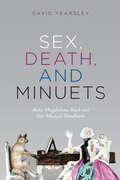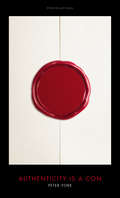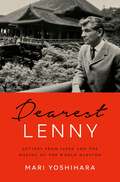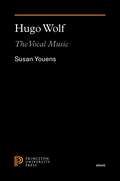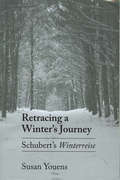- Table View
- List View
Iannis Xenakis’s Persepolis (33 1/3 Europe)
by Aram YardumianIannis Xenakis' Persepolis stood as witness to one of the most important events in modern human history, the Iranian Revolution in 1979. Its existence is owed to an invitation to participate in the 1971 Shiraz Arts Festival, which was overseen by Empress Farah Pahlavi. Like the Festival, and the extravagant celebratory party held the same year, Xenakis' symbolic paean to Persian history was polarizing. Many loved it, others detested it. Overwhelming but also subtle and precise in its non-harmonic shifts in texture and density, listeners and critics simply did not know what to make of it. This book tells the story of Xenakis' early history and involvement in the Resistance against the Axis occupation of Greece during the Second World War, escape and re-settlement in Paris, work as an architect with Le Corbusier, and distinct views on world history and politics that all led to his 1972 electro-acoustic album Persepolis.
Iannis Xenakis’s Persepolis (33 1/3 Europe)
by Aram YardumianIannis Xenakis' Persepolis stood as witness to one of the most important events in modern human history, the Iranian Revolution in 1979. Its existence is owed to an invitation to participate in the 1971 Shiraz Arts Festival, which was overseen by Empress Farah Pahlavi. Like the Festival, and the extravagant celebratory party held the same year, Xenakis' symbolic paean to Persian history was polarizing. Many loved it, others detested it. Overwhelming but also subtle and precise in its non-harmonic shifts in texture and density, listeners and critics simply did not know what to make of it. This book tells the story of Xenakis' early history and involvement in the Resistance against the Axis occupation of Greece during the Second World War, escape and re-settlement in Paris, work as an architect with Le Corbusier, and distinct views on world history and politics that all led to his 1972 electro-acoustic album Persepolis.
Everybody Loves Our Town: A History of Grunge
by Mark YarmGrunge, also known as the 'Seattle sound', is the sludgy fusion of punk rock and heavy metal that emerged from the Pacific Northwest in the early part of the 1980s. But it was the unexpected, seemingly overnight success of Nirvana's single 'Smells Like Teen Spirit,' in the fall of 1991, that made grunge a household word and launched an American music movement on par with punk and hip-hop.Twenty years later, Mark Yarm captures that era in the words of those at the forefront of the movement (and the music's lesser-known champions). Everybody Loves Our Town will tell the whole story: the founding of originators like Soundgarden and the Melvins, the early successes of Seattle's Sub Pop record label, the rise of powerhouses Nirvana and Pearl Jam, the insane media hype surrounding the grunge explosion, the suicide of Kurt Cobain, and finally, the genre's mid-to-late-'90s decline.
Sex, Death, and Minuets: Anna Magdalena Bach and Her Musical Notebooks (New Material Histories of Music)
by David YearsleyAt one time a star in her own right as a singer, Anna Magdalena (1701–60) would go on to become, through her marriage to the older Johann Sebastian Bach, history’s most famous musical wife and mother. The two musical notebooks belonging to her continue to live on, beloved by millions of pianists young and old. Yet the pedagogical utility of this music—long associated with the sound of children practicing and mothers listening—has encouraged a rosy and one-sided view of Anna Magdalena as a model of German feminine domesticity. Sex, Death, and Minuets offers the first in-depth study of these notebooks and their owner, reanimating Anna Magdalena as a multifaceted historical subject—at once pious and bawdy, spirited and tragic. In these pages, we follow Magdalena from young and flamboyant performer to bereft and impoverished widow—and visit along the way the coffee house, the raucous wedding feast, and the family home. David Yearsley explores the notebooks’ more idiosyncratic entries—like its charming ditties on illicit love and searching ruminations on mortality—against the backdrop of the social practices and concerns that women shared in eighteenth-century Lutheran Germany, from status in marriage and widowhood, to fulfilling professional and domestic roles, money, fashion, intimacy and sex, and the ever-present sickness and death of children and spouses. What emerges is a humane portrait of a musician who embraced the sensuality of song and the uplift of the keyboard, a sometimes ribald wife and oft-bereaved mother who used her cherished musical notebooks for piety and play, humor and devotion—for living and for dying.
Sex, Death, and Minuets: Anna Magdalena Bach and Her Musical Notebooks (New Material Histories of Music)
by David YearsleyAt one time a star in her own right as a singer, Anna Magdalena (1701–60) would go on to become, through her marriage to the older Johann Sebastian Bach, history’s most famous musical wife and mother. The two musical notebooks belonging to her continue to live on, beloved by millions of pianists young and old. Yet the pedagogical utility of this music—long associated with the sound of children practicing and mothers listening—has encouraged a rosy and one-sided view of Anna Magdalena as a model of German feminine domesticity. Sex, Death, and Minuets offers the first in-depth study of these notebooks and their owner, reanimating Anna Magdalena as a multifaceted historical subject—at once pious and bawdy, spirited and tragic. In these pages, we follow Magdalena from young and flamboyant performer to bereft and impoverished widow—and visit along the way the coffee house, the raucous wedding feast, and the family home. David Yearsley explores the notebooks’ more idiosyncratic entries—like its charming ditties on illicit love and searching ruminations on mortality—against the backdrop of the social practices and concerns that women shared in eighteenth-century Lutheran Germany, from status in marriage and widowhood, to fulfilling professional and domestic roles, money, fashion, intimacy and sex, and the ever-present sickness and death of children and spouses. What emerges is a humane portrait of a musician who embraced the sensuality of song and the uplift of the keyboard, a sometimes ribald wife and oft-bereaved mother who used her cherished musical notebooks for piety and play, humor and devotion—for living and for dying.
Sex, Death, and Minuets: Anna Magdalena Bach and Her Musical Notebooks (New Material Histories of Music)
by David YearsleyAt one time a star in her own right as a singer, Anna Magdalena (1701–60) would go on to become, through her marriage to the older Johann Sebastian Bach, history’s most famous musical wife and mother. The two musical notebooks belonging to her continue to live on, beloved by millions of pianists young and old. Yet the pedagogical utility of this music—long associated with the sound of children practicing and mothers listening—has encouraged a rosy and one-sided view of Anna Magdalena as a model of German feminine domesticity. Sex, Death, and Minuets offers the first in-depth study of these notebooks and their owner, reanimating Anna Magdalena as a multifaceted historical subject—at once pious and bawdy, spirited and tragic. In these pages, we follow Magdalena from young and flamboyant performer to bereft and impoverished widow—and visit along the way the coffee house, the raucous wedding feast, and the family home. David Yearsley explores the notebooks’ more idiosyncratic entries—like its charming ditties on illicit love and searching ruminations on mortality—against the backdrop of the social practices and concerns that women shared in eighteenth-century Lutheran Germany, from status in marriage and widowhood, to fulfilling professional and domestic roles, money, fashion, intimacy and sex, and the ever-present sickness and death of children and spouses. What emerges is a humane portrait of a musician who embraced the sensuality of song and the uplift of the keyboard, a sometimes ribald wife and oft-bereaved mother who used her cherished musical notebooks for piety and play, humor and devotion—for living and for dying.
Sex, Death, and Minuets: Anna Magdalena Bach and Her Musical Notebooks (New Material Histories of Music)
by David YearsleyAt one time a star in her own right as a singer, Anna Magdalena (1701–60) would go on to become, through her marriage to the older Johann Sebastian Bach, history’s most famous musical wife and mother. The two musical notebooks belonging to her continue to live on, beloved by millions of pianists young and old. Yet the pedagogical utility of this music—long associated with the sound of children practicing and mothers listening—has encouraged a rosy and one-sided view of Anna Magdalena as a model of German feminine domesticity. Sex, Death, and Minuets offers the first in-depth study of these notebooks and their owner, reanimating Anna Magdalena as a multifaceted historical subject—at once pious and bawdy, spirited and tragic. In these pages, we follow Magdalena from young and flamboyant performer to bereft and impoverished widow—and visit along the way the coffee house, the raucous wedding feast, and the family home. David Yearsley explores the notebooks’ more idiosyncratic entries—like its charming ditties on illicit love and searching ruminations on mortality—against the backdrop of the social practices and concerns that women shared in eighteenth-century Lutheran Germany, from status in marriage and widowhood, to fulfilling professional and domestic roles, money, fashion, intimacy and sex, and the ever-present sickness and death of children and spouses. What emerges is a humane portrait of a musician who embraced the sensuality of song and the uplift of the keyboard, a sometimes ribald wife and oft-bereaved mother who used her cherished musical notebooks for piety and play, humor and devotion—for living and for dying.
Blues Harmonica For Dummies
by Winslow YerxaThe fun and easy way to play blues on the harmonica Blues harmonica is the most popular and influential style of harmonica playing, and it forms the basis for playing harmonica in other styles such as rock and country. Blues Harmonica for Dummies gives you a wealth of content devoted to the blues approach—specific techniques and applications, including bending and making your notes sound richer and fuller with tongue-blocked enhancements; use of amplification to develop a blues sound; blues licks and riffs; constructing a blues harmonica solo; accompanying singers; historical development of blues styles; and important blues players and recordings. The accompanying audio CD features all the musical examples from the book, plus play-along exercises and songs that let you hear the sound you're striving for. In-depth coverage of major blues harmonica techniques Blues song forms, improvisation, and accompanying singers Information on blues history and personalities If you're intrigued by the idea of understanding and mastering the compelling (yet mysterious) art of playing blues on the harmonica, Blues Harmonica For Dummies has you covered. CD-ROM/DVD and other supplementary materials are not included as part of the e-book file, but are available for download after purchase
Blues Harmonica For Dummies
by Winslow YerxaThe fun and easy way to play blues on the harmonica Blues harmonica is the most popular and influential style of harmonica playing, and it forms the basis for playing harmonica in other styles such as rock and country. Blues Harmonica for Dummies gives you a wealth of content devoted to the blues approach—specific techniques and applications, including bending and making your notes sound richer and fuller with tongue-blocked enhancements; use of amplification to develop a blues sound; blues licks and riffs; constructing a blues harmonica solo; accompanying singers; historical development of blues styles; and important blues players and recordings. The accompanying audio CD features all the musical examples from the book, plus play-along exercises and songs that let you hear the sound you're striving for. In-depth coverage of major blues harmonica techniques Blues song forms, improvisation, and accompanying singers Information on blues history and personalities If you're intrigued by the idea of understanding and mastering the compelling (yet mysterious) art of playing blues on the harmonica, Blues Harmonica For Dummies has you covered. CD-ROM/DVD and other supplementary materials are not included as part of the e-book file, but are available for download after purchase
Blues Harmonica For Dummies
by Winslow YerxaBlues Harmonica For Dummies (9781119694519) was previously published as Blues Harmonica For Dummies (9781118252697). While this version features a new Dummies cover and design, the content is the same as the prior release and should not be considered a new or updated product.
Blues Harmonica For Dummies
by Winslow YerxaBlues Harmonica For Dummies (9781119694519) was previously published as Blues Harmonica For Dummies (9781118252697). While this version features a new Dummies cover and design, the content is the same as the prior release and should not be considered a new or updated product.
Blues Harmonica For Dummies
by Winslow YerxaBreathe the blues into your harmonica Learn about bending, tongue blocking, and chordal rhythm Connect with blues history and the major players The fun and easy way to play blues harmonica Blues Harmonica For Dummies gives you a wealth of guidance on playing harmonica in the style of the blues masters. Learn how to go from playing easy chords to strong single notes — and then to 12-bar blues. Develop your personal style and put together a repertoire of tunes to play for an audience. Explore specific techniques and applications, including bending and making your notes sound richer and fuller; using amplification; developing blues licks and riffs; performing a blues harmonica solo like a pro; and much more. Inside... A review of the blues as a musical style What it takes to get started A blues guide to music symbols Ways to shape, color, and punctuate your blues sound How to amplify your playing Important blues players and recordings
Blues Harmonica For Dummies
by Winslow YerxaBreathe the blues into your harmonica Learn about bending, tongue blocking, and chordal rhythm Connect with blues history and the major players The fun and easy way to play blues harmonica Blues Harmonica For Dummies gives you a wealth of guidance on playing harmonica in the style of the blues masters. Learn how to go from playing easy chords to strong single notes — and then to 12-bar blues. Develop your personal style and put together a repertoire of tunes to play for an audience. Explore specific techniques and applications, including bending and making your notes sound richer and fuller; using amplification; developing blues licks and riffs; performing a blues harmonica solo like a pro; and much more. Inside... A review of the blues as a musical style What it takes to get started A blues guide to music symbols Ways to shape, color, and punctuate your blues sound How to amplify your playing Important blues players and recordings
Harmonica For Dummies
by Winslow YerxaMaster the harmonica fast with this fun, easy guide Everybody loves the sound of a harmonica, and the thought of learning to play one is even more appealing. The instrument's portability, versatility, and affordability make it a great choice for those interested in learning how to produce the unmistakable, signature sound found in many styles of American music. With Harmonica For Dummies, you can learn to master the harmonica faster than you ever thought possible, even if you have little to no playing experience. This easy-to-use resource is filled with tips, tools, and instructions that will have you playing in no time. In Harmonica For Dummies, you'll find an accessible format designed to help you access new techniques, songs, and styles of playing. Accompanying digital content and interactive tools will help you learn the nuances of playing harmonica and give you the know-how to use this versatile instrument to its fullest potential. Provides you with a high-quality, comprehensive instructional manual Instructs you with detailed instructions and tips to help you learn to play quickly Written in a clear, easy-to-understand format complete with accompanying audio/video content Helps you improve your playing and embrace the many musical styles that have made the harmonica an iconic instrument The harmonica is a very accessible instrument, but only those with the right instruction and direction will be able to experience the joy of using it for accompaniment and solos. Let Harmonica For Dummies guide you through the learning process and make you a harmonica expert in a flash!
Harmonica For Dummies
by Winslow YerxaMaster the harmonica fast with this fun, easy guide Everybody loves the sound of a harmonica, and the thought of learning to play one is even more appealing. The instrument's portability, versatility, and affordability make it a great choice for those interested in learning how to produce the unmistakable, signature sound found in many styles of American music. With Harmonica For Dummies, you can learn to master the harmonica faster than you ever thought possible, even if you have little to no playing experience. This easy-to-use resource is filled with tips, tools, and instructions that will have you playing in no time. In Harmonica For Dummies, you'll find an accessible format designed to help you access new techniques, songs, and styles of playing. Accompanying digital content and interactive tools will help you learn the nuances of playing harmonica and give you the know-how to use this versatile instrument to its fullest potential. Provides you with a high-quality, comprehensive instructional manual Instructs you with detailed instructions and tips to help you learn to play quickly Written in a clear, easy-to-understand format complete with accompanying audio/video content Helps you improve your playing and embrace the many musical styles that have made the harmonica an iconic instrument The harmonica is a very accessible instrument, but only those with the right instruction and direction will be able to experience the joy of using it for accompaniment and solos. Let Harmonica For Dummies guide you through the learning process and make you a harmonica expert in a flash!
Harmonica For Dummies
by Winslow YerxaWail on your harmonica! The harmonica is one of the most popular and versatile instruments in the world. There are several reasons harmonicas are awesome—you can play them anywhere, they’re inexpensive, and you can show off in dozens of musical styles. The friendly and pleasingly tuneful Harmonica For Dummies is the fastest and best way to learn for yourself! You’ll find an easy-to-follow format that takes you from the basics to specialized techniques, with accompanying audio and video content included to make learning even more simple and fun. Before you know it, you’ll be playing jazz in your living room and the blues on your way to work or school—and that’s just the prelude to mastering classical riffs. That’s right, the humble harmonica has graced some of the grandest concert halls on planet Earth! Choose the right harmonica Enhance your sound with tongue technique Develop your own style Perfect your live performance The harmonica is awesome to learn, but even more awesome to learn well, and Harmonica For Dummies will get you on the road from being an occasional entertainer to becoming an accomplished live performer.
Harmonica For Dummies
by Winslow YerxaWail on your harmonica! The harmonica is one of the most popular and versatile instruments in the world. There are several reasons harmonicas are awesome—you can play them anywhere, they’re inexpensive, and you can show off in dozens of musical styles. The friendly and pleasingly tuneful Harmonica For Dummies is the fastest and best way to learn for yourself! You’ll find an easy-to-follow format that takes you from the basics to specialized techniques, with accompanying audio and video content included to make learning even more simple and fun. Before you know it, you’ll be playing jazz in your living room and the blues on your way to work or school—and that’s just the prelude to mastering classical riffs. That’s right, the humble harmonica has graced some of the grandest concert halls on planet Earth! Choose the right harmonica Enhance your sound with tongue technique Develop your own style Perfect your live performance The harmonica is awesome to learn, but even more awesome to learn well, and Harmonica For Dummies will get you on the road from being an occasional entertainer to becoming an accomplished live performer.
Mundharmonika für Dummies (Für Dummies)
by Winslow YerxaDas Buch konzentriert sich auf die diatonische Mundharmonika mit zehn Tonkanälen. Es bietet einen allgemeinen Überblick über das Instrument und darüber, was man als Spieler mitbringen sollte. Behandelt wird auch, was man beim Kauf einer Mundharmonika beachten muss, wie man richtig sowohl Akkorde als auch einzelne Töne spielt, die Bending-Technik zum "Biegen" der Töne, diverse Spieltechniken und Tipps, sowie das Spielen in einer Band oder einem Duo. Dabei hilft eine Grifftabelle, die für jede Übung anzeigt, wo die Finger hinmüssen. Der Autor erklärt außerdem, wie man seine Mundharmonika reparieren oder sogar im Klang verbessern kann und gibt Empfehlungen zu verschiedenen Mundharmonika-Alben.
Singing (Arts for Health)
by J Yoon Irons Grenville HancoxWe are 'hard-wired' to sing - singing has defined our evolution. Through singing we express our feelings, communicate and connect with others. We are all singers: singing is part of us and defines cultures worldwide. Singing also, importantly, makes us feel better: it is, undoubtedly, good for us. This book provides an important overview of current research showing the benefits of singing on our health and wellbeing. Case studies illustrate its power - for example, how singing helps hospitalised children and a man living with Parkinson's. The book also discusses potential barriers for singing and useful strategies needed to overcome them. An example of a community singing group is also demonstrated, alongside practical advice on facilitating community singing groups for health and wellbeing. The book will be valuable to professionals working in health and social care settings, to practitioners and educators interested in engaging in singing for health promotion, and individuals looking to find out more about the benefits and practicalities of singing.
Singing (Arts for Health)
by J Yoon Irons Grenville HancoxWe are 'hard-wired' to sing - singing has defined our evolution. Through singing we express our feelings, communicate and connect with others. We are all singers: singing is part of us and defines cultures worldwide. Singing also, importantly, makes us feel better: it is, undoubtedly, good for us. This book provides an important overview of current research showing the benefits of singing on our health and wellbeing. Case studies illustrate its power - for example, how singing helps hospitalised children and a man living with Parkinson's. The book also discusses potential barriers for singing and useful strategies needed to overcome them. An example of a community singing group is also demonstrated, alongside practical advice on facilitating community singing groups for health and wellbeing. The book will be valuable to professionals working in health and social care settings, to practitioners and educators interested in engaging in singing for health promotion, and individuals looking to find out more about the benefits and practicalities of singing.
Authenticity is a Con: (Provocations) (Provocations Ser.)
by Peter YorkThe idea of authenticity - deliciously vague and as ubiquitous as Starbucks - has hit the spot in almost every sector of 21st-century life. But can we trust the authentic image of Nigel 'man-of-the-people' Farage, Sarah 'hockey mom' Palin or Gwyneth 'inner life' Paltrow? Are punk bands, distressed denim and rustic furniture really as spontaneous as people seem to think? Is bare-brick Shoreditch just one big authenticity scam? From motivational speakers to PR consultants, music entrepreneurs to devoted foodies, bearded hipsters to earnest YouTubers - and, yes, politicians too - 'authentic' has become the buzzword of our age. But, as Peter York has discovered, its meaning has changed and become corrupted: every advertising agency, micro-connoisseur and charlatan going has re-tooled the language of authenticity for our changing market and it is now practically impossible for us to differentiate between authentic and 'authentic'. Drawing on witty anecdotes and analysing various spheres of everyday life, Peter has set out to uncover the truth behind authenticity - the ultimate con of our generation.
Dearest Lenny: Letters from Japan and the Making of the World Maestro
by Mari YoshiharaMuch has been written about Leonard Bernstein, a musician of extraordinary talent who was legendary for his passionate love of life and many relationships. In this work, Mari Yoshihara reveals the deeply emotional connections Bernstein formed with two little-known Japanese individuals, which she narrates through their personal letters that have never been seen before. Dearest Lenny interweaves an intimate story of love and art with a history of Bernstein's transformation from an American icon to a world maestro during the second half of the twentieth century. The articulate, moving letters of Kazuko Amano--a woman who began writing fan letters to Bernstein in 1947 and became a close family friend--and Kunihiko Hashimoto--a young man who fell in love with the maestro in 1979 and later became his business representative--convey the meaning Bernstein and his music had at various stages of their lives. The letters also shed light on how Bernstein's compositions, recordings, and performances touched his audiences around the world. The book further traces the making of a global Bernstein amidst the shifting landscape of classical music that made this American celebrity turn increasingly to Europe and Japan. The dramatic change in Japan's place in the world and its relationship to the United States during the postwar decades shaped Bernstein's connection to the country. Ultimately, Dearest Lenny is a story of relationships--between the two individuals and Bernstein, the United States and the world, art and commerce, artists and the state, private and public, conventions and transgressions, dreams and realities--that were at the core of Bernstein's greatest achievements and challenges and that made him truly a maestro of the world. Dearest Lenny paints a poignant portrait of individuals connected across cultures, languages, age, and status through correspondence and music--and the world that shaped their relationships.
Dearest Lenny: Letters from Japan and the Making of the World Maestro
by Mari YoshiharaMuch has been written about Leonard Bernstein, a musician of extraordinary talent who was legendary for his passionate love of life and many relationships. In this work, Mari Yoshihara reveals the deeply emotional connections Bernstein formed with two little-known Japanese individuals, which she narrates through their personal letters that have never been seen before. Dearest Lenny interweaves an intimate story of love and art with a history of Bernstein's transformation from an American icon to a world maestro during the second half of the twentieth century. The articulate, moving letters of Kazuko Amano--a woman who began writing fan letters to Bernstein in 1947 and became a close family friend--and Kunihiko Hashimoto--a young man who fell in love with the maestro in 1979 and later became his business representative--convey the meaning Bernstein and his music had at various stages of their lives. The letters also shed light on how Bernstein's compositions, recordings, and performances touched his audiences around the world. The book further traces the making of a global Bernstein amidst the shifting landscape of classical music that made this American celebrity turn increasingly to Europe and Japan. The dramatic change in Japan's place in the world and its relationship to the United States during the postwar decades shaped Bernstein's connection to the country. Ultimately, Dearest Lenny is a story of relationships--between the two individuals and Bernstein, the United States and the world, art and commerce, artists and the state, private and public, conventions and transgressions, dreams and realities--that were at the core of Bernstein's greatest achievements and challenges and that made him truly a maestro of the world. Dearest Lenny paints a poignant portrait of individuals connected across cultures, languages, age, and status through correspondence and music--and the world that shaped their relationships.
Hugo Wolf: The Vocal Music
by Susan YouensA groundbreaking look at one of the great song composers of the late Romantic periodIn the virtual cottage industry of works on fin de siècle Vienna, Hugo Wolf (1860–1903) has been somewhat neglected, perhaps because he was the master of a small genre—the late Romantic lied—and never truly made his mark in the larger forms that command greater public attention. But in the realm of song, he is among the greatest inheritors of Schubert and Schumann, one who was both a traditionalist and a modernist. When the Viennese critic Eduard Hanslick disapprovingly dubbed Wolf &“the Richard Wagner of the lied,&” he was paying oblique homage to Wolf&’s genius as a song composer in the most modern manner.In this book, Susan Youens examines five aspects of Wolf&’s compositional art, each exemplifying a different synthesis of traditionalism and modernity and spanning his entire, tragically brief creative life, from his first efforts to his lapse into insanity in 1897. She discusses Wolf&’s youthful imitations of Schumann, his genius for comic songs of a kind unlike any of his predecessors, his part in the ballad revival of the late nineteenth century, Wolf in relation to his contemporaries, and his pursuit of operatic fame. Youens looks as closely at the poetic texts as she does the music and includes numerous previously unpublished sketches and fragments, examples from songs now long out of print and difficult to obtain, and citations from Wolf&’s vivid letters and other sources of the period.
Retracing a Winter's Journey: Franz Schubert's "Winterreise"
by Susan Youens"I like these songs better than all the rest, and someday you will too," Franz Schubert told the friends who were the first to hear his song cycle Winterreise. These lieder have always found admiring audiences, but the poetry he chose to set them to has been widely regarded as weak and trivial. Susan Youens looks not only at Schubert's music but at the poetry, drawn from the works of Wilhelm Müller, who once wrote in his diary, "perhaps there is a kindred spirit somewhere who will hear the tunes behind the words and give them back to me!"Youens maintains that Müller, in depicting the wanderings of the alienated lover, produced poetry that was simple but not simple-minded, poetry that embraced simplicity as part of its meaning. In her view, Müller used the ruder folk forms to give his verse greater immediacy, to convey more powerfully the wanderer's complex inner state. Youens addresses many different aspects of Winterreise: the cultural milieu to which it belonged, the genesis of both the poetry and the music, Schubert's transformation of poetic cycle into music, the philosophical dimension of the work, and its musical structure.



